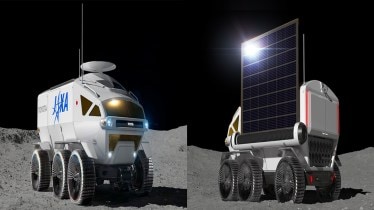Elon Musk’s Tesla Roadster is possibly the most iconic photo of a car in space, but it didn’t serve any major engineering purpose.
Some carmakers, however, are serious about space and are readying self-driving vehicles that can be used on the Moon and Mars, to begin with.
Toyota Lunar Cruiser
Since 2019, the Japan Aerospace Exploration Agency (JAXA) and Toyota have been conducting research on a pressurised rover (called the Lunar Cruiser). This would make it possible to carry out crewed exploration activities on the Moon, one of JAXA’s international space exploration missions. The Moon has one-sixth the gravity of Earth, temperatures ranging from -170 to 120 degrees Celsius, is in vacuum, is bathed in strong radiation, and is covered with lunar sand (regolith). Toyota will offer the Lunar Cruiser the reliability, durability, driving performance and fuel cell technology it has cultivated over years of vehicle development. Technologies developed for the Moon can be fed back to the Earth and used to create better vehicles.
Hyundai lunar exploration rover
Hyundai Motor Group is building a development model of a lunar exploration rover, with major Korean research institutes in the aerospace sector. The rover is designed to explore the Moon’s surface, and the platform includes solar charging, autonomous driving, thermal management and radiation shielding. It can carry equipment on top of the rover with a maximum weight of 70 kg. Hyundai expects completion of the initial development model in the second half of 2024 and aims to create a rover that has launch capability in 2027. Hyundai is utilising its own and Kia’s robotics and autonomous driving technologies (camera, LiDAR), driving system (motor, wheels, suspension), charging parts (solar panel, battery) as well as Hyundai Rotem’s robot manufacturing technology.
Honda’s renewable energy system
Honda has signed a research and development contract with the JAXA regarding the ‘circulative renewable energy system’ to supply electricity to maintain the functionality of the living space and various systems of lunar rovers. Honda will be commissioned by JAXA to first conduct concept studies, and then to develop a ‘breadboard model’, the early-stage prototype, by the end of the Japanese 2023 fiscal year (March 31, 2024).
Audi Lunar quattro
It was a small lunar rover created by engineers from PTScientists, a Berlin-based aerospace company, with the support of Audi. The flight to the Moon was planned for October 2021 on board a SpaceX Falcon 9 two-stage rocket, but did not happen. The Lunar quattro weighs 35 kg, has a top speed of 3.6 km/h, and its four electric motors are powered by solar panels and lithium-ion batteries.
From space to Earth
While automakers are helping develop rovers for space travel, American space agency NASA has a section on its website which notes how space technology has made its way into cars.
1. Comfortable car seats: Nissan turned to NASA research for developing a new driver’s seat. Like an astronaut, the driver of a car needs to be comfortable to operate the vehicle efficiently. After years of research in the 2000s, Nissan debuted the seat derived from NASA standards in the 2013 Altima. Today, the design is in various Nissan models.
2. Tyre sensors: Tyres are important for safe space shuttle landing. NASA contracted with a company to build a tyre pressure sensor for its space shuttle. Today, most cars in the developed world, and cars in India priced above Rs 15-20 lakh, are equipped with tyre pressure sensors.
3. Nanotechnology to repair engine damage: Friction causes wear and tear on spacecraft components. Lubricants that reduce friction only delay this inevitable damage. NASA used liquid lubricant to carry nanoparticles to the point of friction to fill in tiny cracks. Today, this mechanism is used in vehicle to enhance engine life.
4. Heat shield: Racing cars have a heat shield that protect the driver from the extreme heat generated by the engine and transmission. This heat shield was first used to protect the space shuttle from high temperatures experienced as it entered the Earth’s atmosphere.
5. Self-driving cars: NASA says that self-driving technology was first developed for its Moon and Mars rovers, and today it’s being employed by carmakers to develop self-driving cars.
